How Do I Reduce File Size Of Jpeg
The primary style to reduce the file size of an image is past increasing the corporeality of compression. In most image editing applications this is washed by the selections yous make in the "Salvage As" or "Export As" dialog box when saving a PNG, JPG, or GIF. The more compression, the smaller the file will be and the faster it will load on a webpage.
But kickoff, y'all'll need to decide which of the 3 file formats you want to use. If your prototype is a photo with lots of colors or an illustration with gradations and you want to squeeze the file size downwards, JPEG will probably be your all-time choice. If a like photo needs to have lossless compression or transparent areas, and then a PNG-24 will exist required. If you accept a simple graphic with few colors and solid areas, then your all-time choice will be a GIF or PNG-viii. We'll take a look at how to get the best pinch in each of the three file types starting with JPEGs. For data about compressing PNGs or GIFs, delight ringlet downwards this page.
Compressing a JPG
It'south easiest to shrink a JPG (also called JPEG) because at that place's just one thing to consider: quality. When you consign to JPG from an image editing program, you lot'll be prompted to select the quality level you want. You might only see a few choices like: low, medium, high, or maximum. You might exist given a number range, for instance 0 (lowest quality) to 12 (highest quality). Or you lot might be asked to select a per centum from 0% (lowest quality) to 100% (highest quality). Yous should always select the everyman quality that is still suitable for your purpose.
One strategy for selecting the all-time level is to starting time with a fairly high quality setting and if information technology looks OK, try reducing the quality a scrap. If the reduced level looks skillful enough, so endeavor another reduction. When you hitting a quality level that is unsatisfactory, and so dorsum upward to the lowest level that was withal good plenty for your purposes. Always keep in listen what the purpose of the graphic is. If y'all are posting a flower photo to a botanical encyclopedia website, you probably want information technology to be adequately high quality so pocket-size distinguishing details tin be conspicuously seen. If you are posting a flower photo just to celebrate the inflow of bound, then a much lower quality would probably exist fine. Let's take a slice of a flower photo and export it out at half dozen unlike quality settings.
100% quality, 103 KB file size
The image beneath was exported at 100% quality. I would rarely ever need this setting.

lxxx% quality, 48 KB file size
The 80% setting is almost indistinguishable from the 100% setting. But let's see if nosotros can compress it further.

60% quality, 28 KB file size
Fifty-fifty at 60% most people wouldn't find any difference from the 100% setting and since information technology's a quarter the size, it would load 4 times every bit fast.

forty% quality, 17 KB file size
For many general uses, fifty-fifty this 40% quality image would be acceptable. And five times faster to load than the original.

twenty% quality, 12 KB file size
Getting ugly hither.

0% quality, seven KB file size
The blockiness of farthermost JPG compress in very obvious.

Sample photo from FCIT's drove of stock plant photos on the ClipPix ETC website.
Another mode to salvage file size with JPG is to slightly blur the image before you compress it. An paradigm with fewer precipitous edges and crisp details will shrink much smaller. Perhaps y'all intend to use a photo as a background image. That's a perfect case for using a blurred photo. You tin even mistiness just parts of an image and achieve file savings. Below is a photograph of a day lily with a decorated background. The file size is 77 KB when compressed at 60% quality.
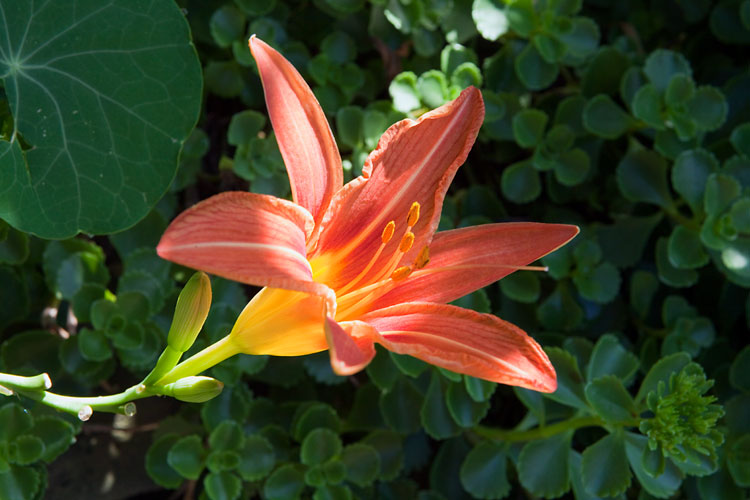
If we take that aforementioned image, select the groundwork in an image editing program similar Photoshop, so blur the selection, only the background will blur and the flower volition remain abrupt. The photograph below was exported to JPG at the same 60% quality setting as above and is only 54 KB—a savings of near 30% of the file size so it will load much faster. In this case, we finish upwards with a slightly more artistic photograph where the focus remains properly on the flower itself and also achieve significant savings in file size. That's a win-win.
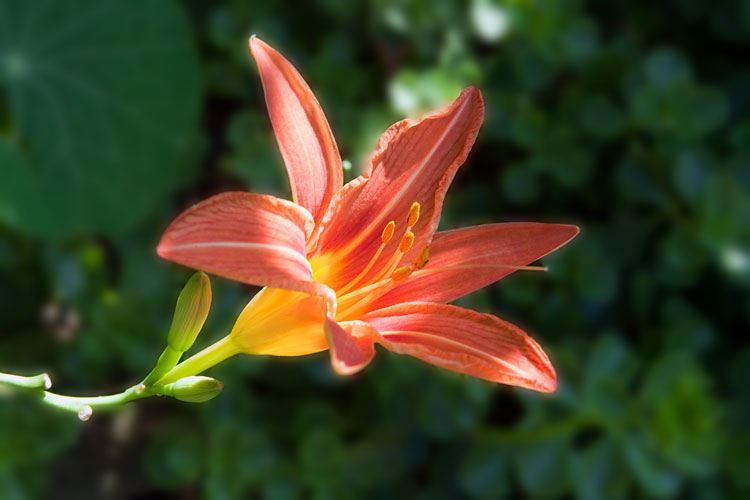
One final notation most JPG. Call up that this is a lossy format. Every time you salve a file every bit a JPG, you lose quality. If yous think that you'll ever want to use the same photo again, make certain you salve your original in a format like TIFF or PSD and and then merely consign the file to JPG. That gives you both the compressed JPG to use on the Web and your original uncompressed file that you can use over again afterward. The one affair you lot definitely don't desire to do is salvage your only re-create of a file as a compressed JPG, reopen information technology to edit, and save information technology out again as a JPG. That's like making photocopies of photocopies. Each time the quality will get worse. It's always better to go back to your original, uncompressed file.
Compressing a GIF
The traditional choice of file blazon for graphics consisting of simple areas and few colors is GIF, although one can at present attain the same results with a PNG-8 (and at a smaller file size).
GIF images are limited to 256 colors, just you can set a lower colour depth for substantial savings in file size. For the best results attempt to get at or simply under one of the following numbers of colors: 256, 128, 64, 32, xvi, viii, 4, or 2. For case, if your prototype has 33 colors in it you lot'll be able to shave off a lot of the file size if you tin reduce the palette to 32 colors, but you won't get the same savings moving from 32 downwards to 31 colors.
See "What is bit depth?" for more data and example images.
When yous save (or consign) as a GIF, first select the number of colors yous want in your final image. Second, if you observe "banding" in areas of gradients, the image probably wasn't a practiced candidate for GIF in the commencement place just yous can make the banding less obvious by selecting a dither pattern—commonly the "diffusion" pattern will work best. 3rd, if yous have transparent areas of your prototype, make certain to select "transparent."
There are a few settings you tin ignore. Exit "Web snap" set to zero. This setting is a left-over from the days when nearly monitors didn't brandish the millions of colors that they do today. The "Matte" setting used to exist very useful for helping alloy the edges of a transparent GIF into the background, but if that'southward a problem for a particular paradigm, you lot should probably switch to PNG anyhow.
And, of course, GIF has been the traditional choice for animated images, although PNG is poised to take over that area as well.

Sample graphic from FCIT's collection of robot illustrations on the TIM website.
Compressing a PNG
We finally get to PNG. It's last on the list not considering it's the least important, but considering it incorporates features of both JPG and GIF. Its popularity has been growing steadily and, by some estimates, is at present used on more than websites than either JPG or GIF. It may seem a fleck more complex at outset, but if you lot volition be creating spider web graphics on a regular footing, it's certainly worth mastering.
Showtime, yous'll need to decide whether to export as PNG-8 or PNG-24. PNG-viii is like GIF in that it's best for graphics with few colors and solid areas like logos. The major difference between PNG-8 and GIF is that the PNG-8 file will generally be smaller than a GIF file. PNG-24 is similar to JPG in that it's best for continuous-tone images similar photographs or other images with more than 256 colors. The major difference betwixt PNG-24 and JPG is that PNG-24 is lossless and so the file size will be somewhat larger than a JPG, only the quality volition be college.
Exporting as a PNG-8. If yous export to PNG-8 from a graphics program you lot volition see an interface that is very similar to GIF. Like a GIF, y'all'll need to select the number of colors (2, 4, 8, sixteen, 32, 64, 128, or 256), whether to add a dither pattern or non, and whether y'all need transparency or not. The simply significant divergence is that the PNG-8 volition exist slightly smaller.
Here'due south a cartoon exported as a 32-color GIF. The file size is xiii.half dozen KB.
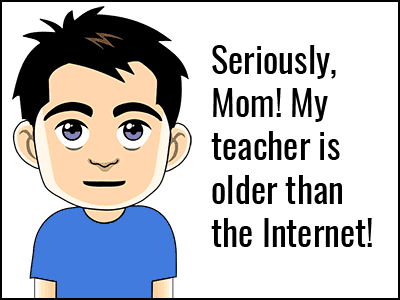
Here's the aforementioned cartoon exported as a 32-color PNG with exactly the aforementioned settings as in a higher place. The file size is 10.ii KB. That's a 25% savings in file size.
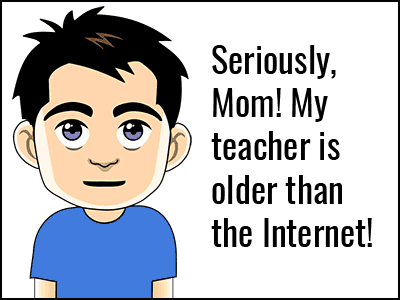
Sample graphic from FCIT's drove of tech cartoons on the TIM website.
Exporting as a PNG-24. Since PNG-24 is a lossless format, you actually don't have any options about quality when exporting. Different a JPG, no paradigm information is discarded. That also ways the file size can exist quite large.
Hither'due south a photo of macaws exported as a PNG-24. Its file size is 400 KB. That's pretty large.
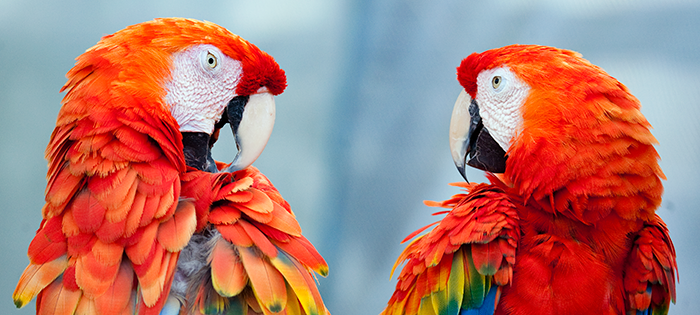
Hither's the same photo exported as a JPG at the maximum quality (100%) setting. Its file size is 259 KB.
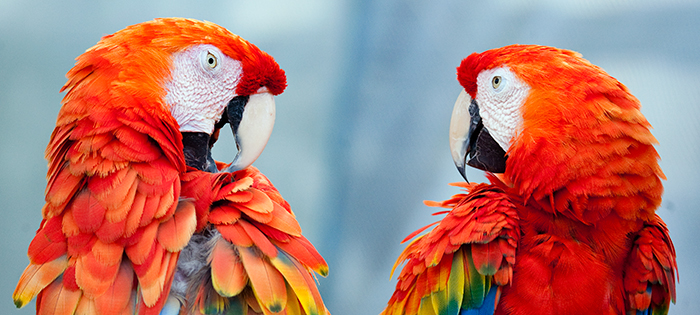
And here's the same photo exported as a JPG at the high quality (60%) setting. Its file size is only 69 KB.
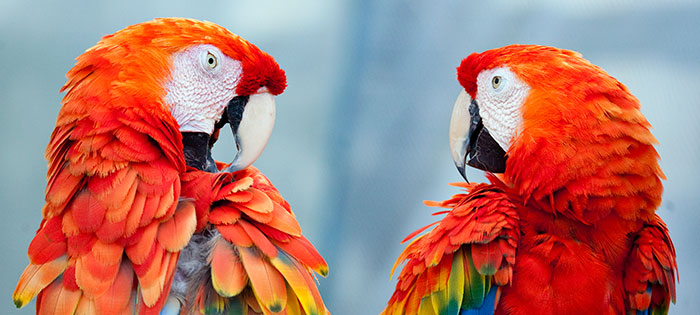
Sample photo from FCIT'southward collection of stockanimal photos on the ClipPix ETC website.
Wow, if the PNG is 5 or 6 times the file size of a serviceable JPG, why would I always want to use it? Well, there could be multiple reasons for choosing the PNG-24 over a JPG.
one. If you need transparency in the epitome, the PNG is necessary considering JPGs don't support transparency.
2. If you want a lossless format, you'll need the PNG considering even at the maximum setting, a JPG loses information and the image degrades even if it is not apparent at first glance.
3. If you absolutely demand a clear image with no JPG pinch artifacts, PNG is your choice. A good example is a screenshot that includes lots of small blazon. By its very nature, a JPG is going to "smudge" the blazon making it slightly harder to read. The PNG will reproduce the blazon pixel-by-pixel only every bit it appeared originally on the screen.
Related pages
What is the difference betwixt bitmap and vector images?
What is scrap depth?
How Do I Reduce File Size Of Jpeg,
Source: https://etc.usf.edu/techease/mac/images/how-do-i-reduce-the-file-size-of-an-image/
Posted by: cotahersh1969.blogspot.com




0 Response to "How Do I Reduce File Size Of Jpeg"
Post a Comment